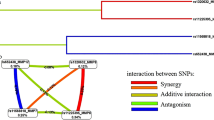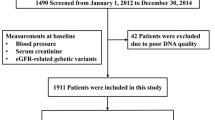Abstract
Ten alleles with length and nucleotide sequence variations were identified in the regulatory region of human tissue kallikrein gene. This present study aimed to study the polymorphisms of the regulatory region of human tissue kallikrein gene of the Chinese and investigate the relationship of the polymorphisms with essential hypertension. A case–control study was conducted in 200 hypertensive and 200 normotensive subjects of unrelated Chinese Han origin. All subjects were aged from 30 to 70 years and had no history of diabetes mellitus, kidney failure, or thyroid gland disease. The alleles were detected by polymerase chain reaction (PCR) and genotyping was performed with allele-specific oligonucleotide analysis (ASO). Data from the essential hypertensive and control subjects were statistically analysed by the Student's t-test and χ2-test. The age- and gender-matching of the groups were accurate. The case group and the control group were in Hardy–Weinberg equilibrium at this locus (cases, P=0.313; control subjects, P=0.457). There were nine alleles among the case and control groups, and the allele frequencies were found to be significantly different between cases and controls (χ2=25.701, P<0.001). The genotype frequencies were also significantly different (χ2=70.100, P<0.001) between these two groups. In conclusion, there are polymorphisms in the regulatory region of human tissue kallikrein gene in the Chinese Han people. Differences in both allele frequencies and genotype frequencies between these two groups have provided evidence towards the association of hypertension with the polymorphisms in this studied site.
This is a preview of subscription content, access via your institution
Access options
Subscribe to this journal
Receive 12 digital issues and online access to articles
$119.00 per year
only $9.92 per issue
Buy this article
- Purchase on Springer Link
- Instant access to full article PDF
Prices may be subject to local taxes which are calculated during checkout
Similar content being viewed by others
References
Meneton P et al. Cardiovascular abnormalities with normal blood pressure in tissue kallikrein deficient mice. Proc Natl Acad Sci USA 2001; 98: 2634–2639.
Campbell DJ . The kallikrein–kinin system in humans. Clin Exp Pharmacol Physiol 2001; 28(12): 1060–1065.
Linz W et al. Contribution of kinins to the cardiovascular actions of angiotensin-converting enzyme inhibitors. Pharmacol Rev 1995; 47: 25–49.
Siragy HM, Jaffa AA, Margolius HS, Carey RM . Renin–angiotensin system modulates renal bradykinin production. Am J Physiol 1996; 271: R1090–R1095.
Harvey TJ et al. Tissue-specific expression patterns and fine mapping of the human kallikrein (KLK) locus on proximal 19q13.4. J Biol Chem 2000; 275: 37397–37406.
Evans BA et al. Structure and chromosomal localization of the human renal kallikrein gene. Biochemistry 1988; 27: 3124–3129.
Lifton RP . Molecular genetics of human blood pressure variation. Science 1996; 272: 676–680.
Pravence M et al. Cosegregation of blood pressure with a kallikrein gene family polymorphism. Hypertension 1991; 17: 242–246.
Wang J et al. Human tissue kallikrein induces hypotension in transgenic mice. Hypertension 1994; 23: 236–243.
Berry TD et al. A gene for high urinary kallikrein may protect against hypertension in Utah kindreds. Hypertension 1989; 13: 3–8.
Berge KE, Berg K . A Taq I RFLP at the human renal kallikrein (KLK1) locus. Clin Genet 1991; 40: 256.
Berge KE, Berg K . No effect of Taq I polymorphism at the human renal kallikrein (KLK1) locus on normal blood pressure level or variability. Clin Genet 1993; 44: 196–202.
Richards RI et al. Human glandular kallikrein genes genetic and physical mapping of the KLK1 locus using a highly polymorphic microsatellite PCR marker. Genomics 1991; 11: 77–82.
Song Q, Chao J, Chao L . DNA polymorphisms in the 5′-flanking region of the human tissue kallikrein gene. Hum Genet 1997; 99: 727–734.
Slim R et al. Loss-of-function polymorphism of the human kallikrein gene with reduced urinary kallikrein activity. J Am Soc Nephrol 2002; 13: 968–976.
Lifton RP, Gharavi AG, Geller DS . Molecular mechanisms of human hypertension. Cell 2001; 104: 545–556.
Staessen JA, Wang J, Bianchi G, Birkenhager WH . Essential hypertension. Lancet 2003; 361: 1629–1641.
Clements JA . The glandular kallikrein family of enzyme: tissue specific expression and hormonal regulation. Endocr Rev 1989; 10: 393–419.
Bhoola KD, Figueroa CD, Worthy K . Bioregulation of kinins: kallikreins, kininogens, and kininases. Pharmacol Rev 1992; 44: 1–80.
Margolius HS . Tissue kallikreins and kinins: regulation and roles in hypertensive and diabetic diseases. Ann Rev Pharmacol Toxicol 1989; 29: 343–364.
Overlack A . Antihypertensive effect of orally administered glandular kallikrein in essential hypertension. Results of double blind study. Hypertension 1981; 3: 118–121.
Ogawa KT . Effects of orally administered glandular kallikrein on urinary kallikrein and prostaglandin excretion, plasma immunoreactive prostanoids and platelet aggregation in essential hypertension. Klin Wochenschr 1985; 63: 332–336.
Xiong W, Chao J, Chao L . Muscle delivery of human tissue kallikrein gene reduces blood pressure in spontaneously hypertensive rats. Hypertension 1995; 25: 715–719.
Harrap SB . Where are all the blood-pressure genes? Lancet 2003; 361: 2149–2151.
Margolius HS, Horwitz D, Pisano JJ, Keiser HR . Urinary kallikrein in hypertension: Relationship to sodium intake and sodium-retaining steroid. Circ Res 1974; 35: 820–825.
Cotton RG . Current methods of mutation detection. Mutat Res 1993; 285: 125–144.
Acknowledgements
We thank especially the participants in the study, and the doctors, nurses and administrative staff in hospitals who assisted with the study. This work was supported by the National Nature Science Foundation of China (No 39970275 to Wang Z, No 30070198 and 30470684 to Wan C) and CMB.
Author information
Authors and Affiliations
Corresponding author
Rights and permissions
About this article
Cite this article
Hua, H., Zhou, S., Liu, Y. et al. Relationship between the regulatory region polymorphism of human tissue kallikrein gene and essential hypertension. J Hum Hypertens 19, 715–721 (2005). https://doi.org/10.1038/sj.jhh.1001875
Received:
Accepted:
Published:
Issue Date:
DOI: https://doi.org/10.1038/sj.jhh.1001875
Keywords
This article is cited by
-
Epistatic study reveals two genetic interactions in blood pressure regulation
BMC Medical Genetics (2013)
-
A common polymorphism in the tissue kallikrein gene is associated with increased urinary excretions of calcium and sodium in Japanese volunteers
Journal of Human Genetics (2013)
-
Renal kallikrein excretion and epigenetics in human acute kidney injury: Expression, mechanisms and consequences
BMC Nephrology (2011)
-
Effects of protein coding polymorphisms in the kallikrein 1 gene on baseline blood pressure and antihypertensive response to irbesartan in Chinese hypertensive patients
Journal of Human Hypertension (2011)
-
Genome-wide Linkage Analysis of Pulse Pressure in American Indians: The Strong Heart Study
American Journal of Hypertension (2008)



